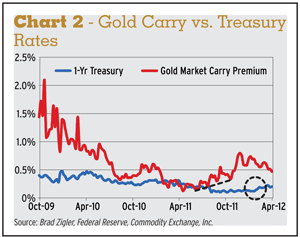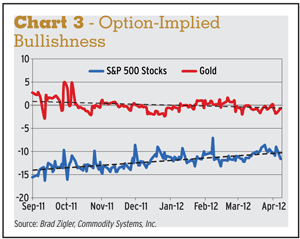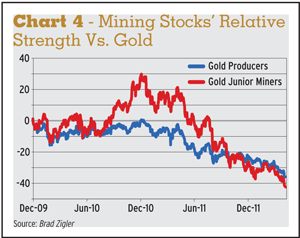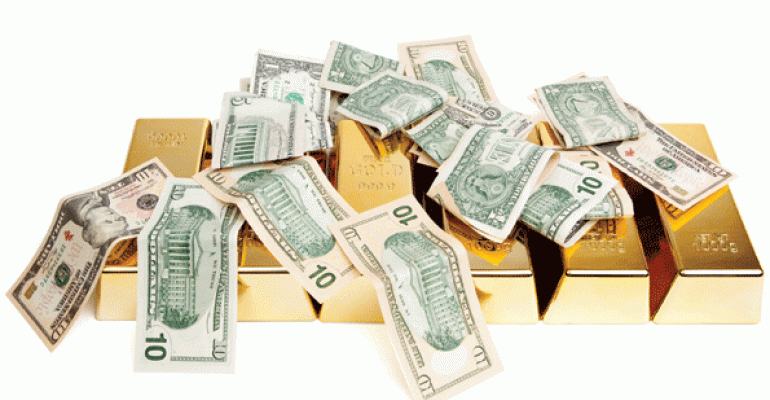In the aftermath of the 2008-2009 market meltdown, investors piled into gold mining issues, Treasury bonds and high-dividend stocks. The dividend play has now become very crowded and the wheels on the mining stock bus are wobbling dangerously — but a novel twist in corporate payouts could, in one fell swoop, generate new interest.
Gold Resource Corp. (NYSE Amex: GORO), a low-cost bullion producer, recently offered its shareholders the option of taking dividends in gold instead of greenbacks. For die-hard deriders of fiat currency, this is truly manna. Or, at least it seems so.
On closer inspection, though, taking all one's dividends in metal may not be such a boon. We have to back up a little to explain why.
Cast of Characters
First of all, we need to take a look at the source of the dividend. Gold Resource Corp. began commercial production in 2010 from its six gold and silver properties in Mexico's southern state of Oaxaca. Since then, the company's paid monthly dividends totaling more than $41 million. Those dividends — paid on 52.9 million shares outstanding — have been hiked from 3 cents a share to a nickel as the price of gold has risen. The company now targets dividend distributions of approximately one-third of its cash flows.
Gold Resource Corp. relies upon Gold Bullion International (GBI), a New York-based private company, to facilitate the conversion and distribution of its dividends. GBI, which recently appointed Sallie Krawcheck, a past president of Bank of America Corp.'s Global Wealth Management group, is a precious metals provider to institutional asset managers and the wealth management industry. The company acquires metal on behalf of its clients for vaulting in New York, London, Salt Lake City and Zurich.
GBI's Physical Dividend Program is, in essence, being road-tested by Gold Resource Corp. as the gold producer is actually GBI's partner on the dividend platform. Gold Resource Corp. shareholders — and, presumably, shareholders of other companies that may later enroll in the program — have the option of taking their dividends in the form of so-called Double Eagle rounds. Gold Resource Corp. produces these gold and silver one-ounce coins in 0.999 fineness. And therein lies the first wrinkle in the dividend scheme: to get the immediate benefit of a cash-to-bullion conversion, investors need to hold large stakes in Gold Resource Corp.
With silver trading in the low $30 range now, an investor needs a cache of 600 GORO shares to get her monthly dividend paid in white metal. If she wants her payout in gold, though, a stash of nearly 33,000 shares is required. Why's that? Because the minimum conversion from a cash dividend to bullion is one ounce. No 10-gram wafers here, just one-ounce rounds.
How It Works
Here's how the dividend conversion works. A Gold Resource shareholder uses an online platform to create an “individual bullion” account at Gold Bullion International after arranging the deposit of her shares at Compushare, Gold Resource's transfer agent. Shares have to be registered in the owner's name for conversions, so Street name holdings at a brokerage are verboten. Gold Resource shareholders then can manage their bullion account online and may opt out at any time. (Those choosing not to participate in the conversion program continue to receive their dividends in cash.)
When Gold Resource Corp. distributes a dividend, it directs GBI to draw gold and silver Double Eagles from Gold Resource's minted physical treasury and to distribute the metal as directed by program shareholders.
Conversions are priced off the afternoon London bullion fixture on dividend record dates, subject to an additional $30-per-coin minting charge. Delivery to shareholders' bullion accounts occurs on dividend payment dates. Investors receiving dividends that fall short of the one-ounce bullion price accrue their cash dividends in their bullion account until the balance rises to a level that allows them to purchase coins. No interest is earned on the cash accumulating in bullion accounts.
If the shareholder elects, GBI can inventory her metal. Storage at an insured vault runs 50 basis points (0.50 percent) per annum for gold, 60 basis points for silver. Alternatively, the investor can opt to receive coins at a destination of her choice, subject to shipping and insurance costs.
Conversion: Boon or Bane?
At first blush, taking dividends in precious metals rather than cash seems to make more economic sense given bullion's recent upward bias. More, however, isn't necessarily better when it comes to dividend conversions. There's no track record yet for the GBI precious metals dividend program (Gold Resource's first payout from the platform is due in April 2012), but we can compare the hypothetical results of taking bullion versus cash by looking back over the company's 20-month dividend history.
Let's first assume we have an institutional-sized GORO holding — say, 55,000 shares — that allows us the flexibility to immediately start taking dividends in metal. To be of record for Gold Resource's first dividend payment in August 2010, a $775,000 investment would have been required. With such a large investment, we have the additional flexibility to opt for a minimum one-ounce conversion or to accrue gold at a faster pace. The initial 3-cent dividend payable in August 2010, for example, represents a $1,650 payout. With a gold cost of $1,253.50 (a London fix at $1,223.50 together with a $30 minting premium), a one-ounce round could be banked as well as $396.50 in our bullion account. If we elect to convert our subsequent dividends into single coins, the cash balance in our account could grow substantially faster than it would we if invested our dividends in additional bullion rounds.
There would have been no monetary difference in the two tactics for the first four months as cash accumulated in the bullion account. Then, in December 2010, enough excess money would have been amassed to permit the acquisition of two ounces in the fast-paced account rather than just one.
Employing this technique over the next 15 monthly dividend cycles would stack 20 gold rounds in the “slow” account, together with nearly $17,500 in cash after storage costs. The “fast” account would accumulate 26 ounces over the same period, leaving a cash balance of just under $1,500. For a shareholder willing to keep his dividends in cash for deposit into one-month CDs, nearly $42,960 could have been piled up by the end of March 2012. Chart 1 illustrates the side-by-side cumulative results.
Looking at the chart, one thing becomes readily apparent. By August 2011, the slow account's value surpassed that of the fast account. Table 1 tells the tale in detail.
The differential gain between the two gold accounts is due to the interplay of a rising dividend payout rate and fluctuations in the market price of gold. Payouts were raised by Gold Resource Corp. as a result of higher gold revenues. This proves to be a double-edged sword as it would have facilitated additional conversions at higher prices in the fast account. Indeed, the average cost of gold in the slow account would have been $1,271 an ounce compared to the fast account's mean acquisition price of $1,594.
What's Next?
This, of course, is a hypothetical scenario. Is it likely to play out in the future? Well, it certainly could, if interest rates remain low and if gold prices exhibit a bullish bias. So, what are the odds?
We can look to the gold market itself for some clues about interest rates. The spread between gold futures delivery months imply an interest rate at which gold inventory is financed or “carried” into the future. Shifts in the gold carry rate tend to be predictive of short-term interest rates. Chart 2 depicts the gold market's carry premium over one-year Treasuries. As you can see, the bottoming in carry rates signalled by the upward-sloping trend line presaged the turnaround in Treasury rates — marked by the circle — by six months.
Despite some recent volatility, interest rates seem likely to move higher going forward as we appear to be bumping along a bottom now. Higher rates would make cash dividends more attractive.
And what of gold? Where is bullion headed? To assess the risk in the gold market, we need to look to those market participants who know risk best — option dealers. Market makers shade option premiums with their volatility assumptions. Premiums are nudged higher when volatility's expected to rise — a typical consequence of a bear trend. Conversely, option costs shrink when volatility expectations are dampened in anticipation of a rising market.
If we plot the volatility skews for options on S&P 500 and gold securities (see Chart 3), we can see market makers are pricing stock index options rather bullishly but are making book on a gradual erosion in gold prices.
So, the market's telling us the odds favor higher interest rates and weak gold prices. What of gold mining stocks themselves, the source of the dividends we've examined? Relative to gold, miners have been something of a bust since peaking in late 2010. Chart 4 maps the relative strength of gold producer and junior mining companies versus bullion. The trend is definitely down. Does that mean there'll be bottoming soon? Perhaps, but nothing says mining issues can't weaken even more.
To sum up, we'd all do well to remember the Roman playwright Terence who first gave voice on stage to the notion of pursuing “moderation in all things.” The numbers — and the pictures — seem to back up the ancient's sagacity, at least with respect to taking dividends in bullion.





